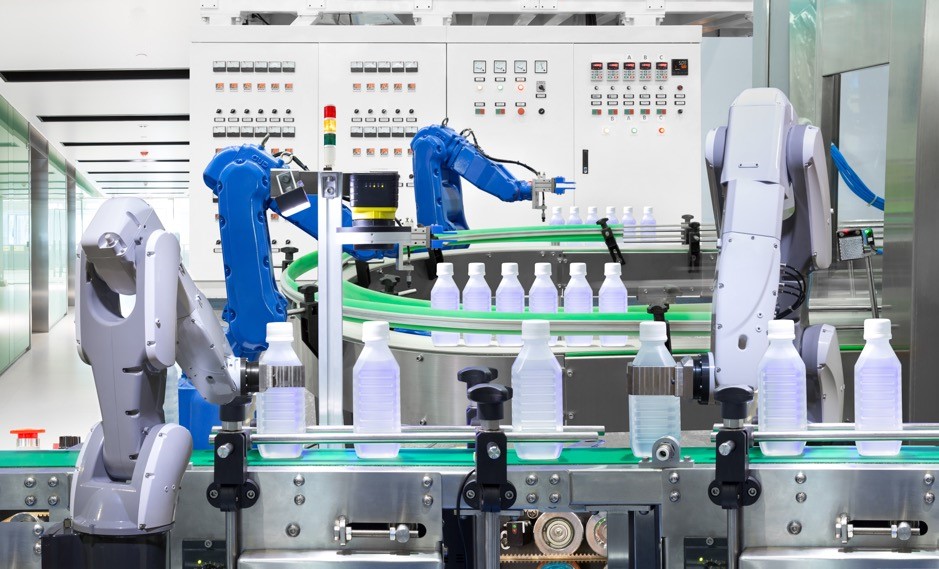We are presently undergoing an industrial revolution.
The principles and advancements of Industry 4.0 are transforming the practices of manufacturers, providing the essential insights and data to build secure and sustainable production facilities capable of addressing both current and future requirements.
Start Your Industry 4.0 Journey Today!
Nevertheless, numerous manufacturers continue to rely on traditional, often manual, processes and procedures, possibly due to the perceived magnitude of change associated with adopting an Industry 4.0-enabled approach.
In this blog, we interview Adem Kulauzovic, Director of Coding Automation at Domino, to emphasize how beginning with modest steps can enhance efficiencies for the future. Additionally, we present specific instances where manufacturers can already employ Industry 4.0 to tackle prevalent and expensive production challenges, leading to enhanced production line efficiency.
To Start
While Industry 4.0 and IoT present excellent opportunities for innovative approaches in manufacturing, the initial strategy is to keep things simple and gradually expand upon successful endeavors.
Adem Kulauzovic advises against rushing into complex solutions, stating, “Don’t try to run before you can walk. Start small, identify some quick wins, and simultaneously, begin planning which areas of your production line to prioritize.”
The plethora of features in Industry 4.0 can be overwhelming, but it’s essential to invest in technology with practical applications.
“Begin by pinpointing the most significant or glaring issue in your operations,” Kulauzovic suggests. “Then, work on implementing a solution to address and overcome this challenge.”
Case 1:Optimising Product Changeovers
Inefficient product changeovers stand out as a major contributor to downtime on production lines, leading to significant financial losses over time.
Adem Kulauzovic shares a recent scenario, stating, “We were recently approached by a Domino customer to address precisely this issue. The customer, a prominent spice mix producer, was spending up to half an hour changing the webbing on their lines when transitioning to a new production run.”
To diminish changeover time, proactive measures can be taken by ensuring production workers are well-prepared. This involves implementing a monitoring solution that provides a real-time product count, accompanied by alerts notifying production staff when a production run is nearing completion.
“For the spice manufacturers, we employed QuickDesign, Domino’s coding automation software, to monitor the printers and send an automated alert 15 minutes before a production run concluded. This allowed production staff to prepare the spice webbing in advance.
“This simple adjustment significantly reduced the changeover time for the customer, from 30 minutes to just 15. As a result, they could accommodate two extra runs per day, a substantial improvement that essentially eliminated the need for an entire shift of overtime.”
Case 2: Minimising Manual Data Input
Globally, operator errors rank among the primary causes of labelling mistakes, potentially leading to costly product recalls if left undetected. Even when identified early, the expenses associated with an incorrect code, in terms of rework and wasted inventory, can accumulate swiftly.
Adem Kulauzovic highlights this issue, stating, “Some customers frequently had to halt production lines due to incorrect codes. This not only results in significant downtime and increased production waste but is also a problem easily rectified without extensive changes to production processes.”
Straightforward automated solutions can replace the necessity for manual data entry on production lines. For instance, a barcode scanner can be employed to automatically populate product labels based on an existing production order. Alternatively, leveraging IoT technology, printers can be configured to automatically fill label templates from a central database.
To streamline processes further, in facilities with multiple production lines, coding automation software like Domino’s QuickDesign enables the networking of printers. This allows production line staff to automatically retrieve product label data from a central location, such as a production office.
“Simple solutions can have a profound impact on overall production facility efficiency,” notes Kulauzovic. “Customers have reported that up to 30% of production downtime was attributed to coding errors. By eliminating the need for manual data entry, this figure can be reduced to 0%. That equates to a substantial increase in production capacity annually, without requiring additional manpower.”
RELATED: Coding Automation: Eliminate Coding Errors From Your Production Line

Case 3: Enhancing Reporting
In traditional production setups, machines often operate independently, with monitoring and reporting responsibilities delegated to production floor teams. In instances of issues, the reported root cause may not accurately pinpoint the underlying problem.
A recent scenario with a Domino customer exemplifies this situation. The customer encountered problems with their case coder, as their production line machines were not interconnected, necessitating manual recording of all issues on a clipboard.
According to the logs maintained by the operator, the case coder was identified as a significant contributor to the company’s wasted inventory and unexpected downtime, with the attributed reason marked as “machine down due to poor code.” Upon an on-site visit, a Domino technician determined that the true cause of the error was a malfunction in the case erector, leading to mispositioning of the coder.
Integrating line machinery with coding automation software offers enhanced visibility into production line operations, enabling manufacturers to pinpoint error sources. This improvement in reporting allows manufacturers to discern necessary enhancements for increased production line efficiency and to rectify causes of downtime.
With Domino QuickDesign, this capability extends further to generate production reports that furnish accurate, unbiased insights into production line performance. By adhering to industry standards and integrating with existing SCADA or SAP systems, QuickDesign can access production data across production lines, generating reports based on print counts, rejection rates, product changeovers, and time shifts.
Example 4: Realising Integration Benefits
“When I think of Industry 4.0, the two key words that come to mind are ‘integration’ and ‘connectivity’,” notes Kulauzovic. “This new revolution isn’t about new technology – it’s about optimizing the technology that already exists.”
Enabling machinery and systems to collaborate allows manufacturers to significantly enhance their production capabilities. For instance, integrating machinery with an existing ERP or MES system through coding automation software presents opportunities to automate product changeovers and streamline production schedules.
Domino printers can seamlessly integrate with prevailing planning systems using Domino’s QuickDesign software to autonomously fetch and disseminate product information to multiple printers situated across a production facility. The software retrieves instructions from an MES or ERP system, utilizing the information to imprint the correct code on the designated product at the designated time.
This proves particularly advantageous in industries mandating variable data printing for regulatory compliance, such as pharmaceuticals, medical devices, and horticulture (e.g., the new ‘Plant Passport‘).
Empower Your Team
In his book “The Fourth Industrial Revolution,” Professor Karl Schwab, Founder and Executive Chairman of the World Economic Forum, urged leaders and citizens to collaborate in “shaping a future that works for all by putting people first, empowering them, and constantly reminding ourselves that all of these new technologies are first and foremost tools made by people for people.”
In any discussion about Industry 4.0, the argument often arises that increased automation will replace manual workers with machines. This perspective is misleading and overlooks the numerous opportunities that increased automation brings.
Traditional production lines can be stressful environments—high pressure, fast-paced, and prone to errors. With Industry 4.0, the aim is to alleviate some of the stress associated with manual production work, allowing workers to utilize their time more productively.
Consider data entry as an example. It’s one of several tasks that the average production worker may perform daily. Automating such tasks eliminates tedious responsibilities, allowing workers to focus on more meaningful aspects of their roles.
“Industry 4.0 is not about replacing manual workers with machines,” states Kulauzovic. “It’s about reinventing production lines to enhance efficiency, directing workers to areas where their contributions matter most—tasks that go beyond menial production responsibilities.”
Fundamentally, Industry 4.0 holds the potential for a more fulfilling factory work experience. It provides operatives with a more engaging work environment, greater autonomy in workplace tasks, and, importantly, opportunities for self-development within the workplace.
The introduction of new systems and processes creates opportunities for workers to undergo retraining or specialize in new areas, enabling them to better leverage the analytics provided by coding automation.
“Aside from constructing a factory of the future, manufacturers should strive to foster a culture of employees equipped with the skills and experience to efficiently capitalize on the opportunities presented by Industry 4.0,” emphasizes Kulauzovic.

Continue Your Company’s Journey
We’ve established that Industry 4.0 doesn’t require an all-encompassing commitment—it involves progressive stages that manufacturers can pursue, utilizing specific aspects to enhance production line efficiency without fully automating every production aspect. As we’ve observed, beginning with small steps can yield genuine performance improvements.
“A lot of people gain deeper insights into their industry or factory when they start incorporating Industry 4.0,” notes Kulauzovic. “Accessing key data about a production facility reveals issues that may have traditionally gone unnoticed.”
By automating straightforward processes and leveraging the production data provided by Industry 4.0 and coding automation, manufacturers can enhance their understanding of production lines and uncover additional benefits that further automation could deliver.
The crucial aspect of Industry 4.0 is to start by addressing minor issues that collectively have a significant impact. Overcoming production bottlenecks allows manufacturers to boost efficiency and gain more insights into their production processes, setting the stage for innovative solutions in the future.
If you want to learn more about the advantages coding automation can bring to your product lines, please reach out. Our industry experts are available to discuss your specific requirements and assist you at any stage of your Industry 4.0 journey.

